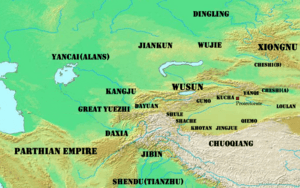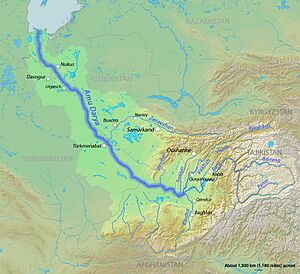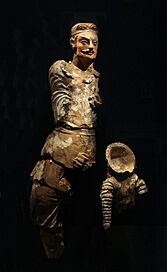Yuezhi facts for kids
|
Figures in the embroidered carpets of the Noin-Ula burial site, thought to be Yuezhis (1st century BC - 1st century AD).
The journeys of the Yuezhi through Central Asia, from around 176 BC to 30 AD
|
|
| Total population | |
|---|---|
| Some 100,000 to 200,000 horse archers, according to the Shiji, Chapter 123. The Hanshu Chapter 96A records: 100,000 households, 400,000 people with 100,000 able to bear arms. | |
| Regions with significant populations | |
| Western China | (pre-2nd century BC) |
| Central Asia | (2nd century BC-1st century AD) |
| Northern India | (1st century AD-4th century AD) |
| Languages | |
| Bactrian (in Bactria in the 1st century AD) | |
| Religion | |
| Buddhism Hinduism Jainism Shamanism Zoroastrianism Manichaeism Kushan deities |
|
The Yuezhi (Chinese: 月氏; pinyin: Yuèzhī) were an ancient group of people. Chinese history books first described them as nomads. They lived in a dry, grassy area in what is now Gansu province in western China. This was during the first thousand years before Christ.
After a big defeat by the Xiongnu people in 176 BC, the Yuezhi split into two groups. These were the Greater Yuezhi (Dà Yuèzhī) and the Lesser Yuezhi (Xiǎo Yuèzhī). This split caused many changes across Asia for centuries.
The Greater Yuezhi first moved northwest into the Ili Valley. This area is now on the border of China and Kazakhstan. They pushed out some of the Sakas people there. Later, the Wusun people drove them from the Ili Valley. The Greater Yuezhi then moved south to Sogdia and later settled in Bactria. Many historians believe the Greater Yuezhi are the same people mentioned in old European writings. These writings say they took over the Greco-Bactrian Kingdom.
During the 1st century BC, one of the five main Greater Yuezhi tribes in Bactria, called the Kushanas, started to take control. They brought other tribes and nearby peoples under their rule. The Kushan Empire grew very powerful. At its peak in the 3rd century AD, it stretched from Turfan in the north to Pataliputra in India in the south. The Kushanas were very important for trade on the Silk Road. They also helped bring Buddhism to China.
The Lesser Yuezhi moved south towards the Tibetan Plateau. Some of them settled among the Qiang people in Qinghai. They were involved in a rebellion against the Han dynasty later on. Another group of Lesser Yuezhi might have founded the city of Cumuḍa (now Hami) in the eastern Tarim region.
Many experts think the Yuezhi were an Indo-European people.
| Timeline of the Yuezhi | |
|---|---|
| Before 221 BCE |
The Yuezhi are strong near Dunhuang. They control the jade trade from the Tarim basin. |
| 215 BCE | The Xiongnu are defeated by the Qin dynasty. They move north into the Mongolian Plateau. |
| 207 BCE | The Xiongnu start raiding the Yuezhi. |
| Circa 176 BCE |
The Xiongnu badly defeat the Yuezhi. |
| 173 BCE | The Yuezhi defeat the Wusun. |
165 BCE |
Most of the Yuezhi start moving west to the Ili valley. This group becomes the "Great Yuezhi". |
| 132 BCE | The Wusun attack the Great Yuezhi. They force them south from the Ili valley. |
| 132–130 BCE | The Great Yuezhi move west and then south. They settle in north-west Bactria. |
| 128 BCE | A Chinese envoy named Zhang Qian visits the Great Yuezhi. |
| Circa 30 CE |
One of the five Great Yuezhi tribes, the Kushana, becomes powerful. They form the Kushan Empire. |
Contents
How Do We Know About the Yuezhi?
The earliest detailed story about the Yuezhi comes from a Chinese book. It's called the Records of the Great Historian. This book was written by Sima Qian in the late 2nd century BC. It describes a trip by a Chinese official named Zhang Qian. A very similar story is also in the Book of Han.
The Chinese name Yuèzhī (月氏) means "moon" and "clan."
Yuezhi and the Xiongnu
At the start of the 2nd century BC, the Yuezhi lived in the grasslands northwest of China.
One old text says:
The Great Yuezhi was a nomadic group. They moved with their animals and had similar customs to the Xiongnu. They had over one hundred thousand soldiers. They were strong and looked down on the Xiongnu. In the past, they lived between Dunhuang and Qilian.
The area mentioned is in western Gansu province today. However, no old Yuezhi remains have been found there yet. Some experts think "Dunhuang" might mean a mountain in the Tian Shan range. This would place the Yuezhi homeland further northwest in modern Xinjiang.
The Xiongnu grew stronger over time. They fought at least four wars with the Yuezhi. In the first war, the Xiongnu king Touman attacked the Yuezhi. His son, Modu, was a hostage with the Yuezhi. Modu escaped and later became the Xiongnu ruler. The Xiongnu did not win this first war.
The second war happened in 203 BC. The Xiongnu took a large part of the Yuezhi land. The Yuezhi's power began to weaken. The third war was around 176 BC. In this war, the Yuezhi were badly defeated.
Around 176 BC, the Xiongnu, led by one of Modu's chiefs, attacked the Yuezhi in Gansu. They won a huge victory. Modu later wrote to the Chinese emperor. He boasted that his fighters and horses had "wiped out the Yuezhi." He said they had killed or forced every member of the tribe to surrender.
Modu's son, Laoshang Chanyu, later killed the Yuezhi king. Following their traditions, he "made a drinking cup out of his skull." The murdered king's wife became the new leader of the Greater Yuezhi.
The Great Yuezhi Move West
After their defeat by the Xiongnu, the Yuezhi split. The Lesser Yuezhi moved to the "southern mountains." These are thought to be the Qilian Mountains near the Tibetan Plateau. They lived with the Qiang people.
The Greater Yuezhi began moving northwest around 165 BC. They first settled in the Ili valley, north of the Tian Shan mountains. There, they defeated the Sai (Sakas) people. This was the first recorded movement of people from the high plateaus of Asia.
In 132 BC, the Wusun people, with help from the Xiongnu, forced the Yuezhi out of the Ili Valley. The Yuezhi had to move southwest. They passed through the city of Dayuan (in Ferghana). They then settled north of the Oxus River, in northern Bactria. This area is now parts of Tajikistan and Uzbekistan.
Zhang Qian's Visit

A Chinese mission, led by Zhang Qian, visited the Yuezhi in Bactria in 126 BC. China wanted to form an alliance with the Yuezhi against the Xiongnu. But the Yuezhi refused. They were living peacefully in Bactria and did not want revenge. Zhang Qian stayed for a year. He wrote a detailed report in the Shiji about Central Asia at that time.
Zhang Qian reported:
The Great Yuezhi live 2,000 or 3,000 li [about 832–1,247 kilometers] west of Dayuan, north of the Gui [Oxus ] river. They are bordered on the south by Daxia [Bactria], on the west by Anxi [Parthia], and on the north by Kangju. They are nomads, moving with their herds. Their customs are like those of the Xiongnu. They have about 100,000 or 200,000 archer warriors.
He also described the people of Central Asia:
Even though the states from Dayuan west to Anxi (Parthia) speak different languages, their customs are generally similar. Their languages can be understood by each other. The men have deep-set eyes and thick beards. They are good at trading and will bargain for even a tiny amount. Women are highly respected, and men make decisions with their women's advice.
Zhang Qian also said that the remains of the Greco-Bactrian Kingdom were on the other side of the Oxus River. These were small city-states under Yuezhi control.
Later Chinese Records
The next time the Yuezhi are mentioned in Chinese books is in the Book of Han. This book was finished in 111 AD. It describes the Yuezhi in the early 1st century BC. At this time, the Yuezhi controlled all of Bactria. They were organized into five main tribes, called xīhóu (Allied Prince). These tribes were:
- Xiūmì in western Wakhān;
- Guìshuāng in Badakhshan and areas north of the Oxus;
- Shuāngmí in the region of Shughnan or Chitral;
- Xīdùn in the region of Balkh; and
- Dūmì in the region of Termez.
The Book of the Later Han (from the 5th century CE) also says that Yuezhi visitors came to the Chinese capital in 2 BC. They taught about Buddhist scriptures. This suggests that some Yuezhi already followed Buddhism in the 1st century BC.
Chapter 88 of the Book of the Later Han tells us more. It says that one of the five Yuezhi tribes, the Guishuang, took control of the others.
More than a hundred years later, the xihou of Guishuang, named Qiujiu Que (Kujula Kadphises), attacked and wiped out the four other xihou. He made himself king of a kingdom called Guishuang (Kushan). He invaded Anxi (Parthia) and took the Gaofu (Kabul) region. He also defeated all the kingdoms of Puda and Jibin (Kapiśa-Gandhāra). Qiujiu Que was over eighty years old when he died.
His son, Yan Gaozhen (Vima Takto), became king. He returned and defeated Tianzhu (Northwestern India). He put a General in charge there. The Yuezhi then became very rich. All the kingdoms call [their king] the Guishuang (Kushan) king. But the Han still call them by their original name, Da Yuezhi.
Later Chinese writings continued to use the name Yuezhi. They rarely used Kushan as a general term.
The Kushan Empire
The people in Central Asia who called themselves Kushana were among those who conquered the Greco-Bactrian Kingdom in the 2nd century BC. Many believe they came from a ruling family or tribe of the Yuezhi. The part of Bactria they settled became known as Tokharistan.
The Kushana people spoke Bactrian. This is an Eastern Iranian language.
In Bactria
In the 3rd century BC, Alexander the Great conquered Bactria. It was then settled by the Hellenistic civilization (Greek culture) of the Seleucids. The Greco-Bactrian Kingdom lasted until the 2nd century BC. This area faced attacks from different nomadic groups. The Greek city of Alexandria on the Oxus was burned around 145 BC. The last Greco-Bactrian king, Heliocles I, moved his capital to the Kabul Valley.
Around 140–130 BC, nomads conquered the Greco-Bactrian state. The Greek geographer Strabo wrote about this. He mentioned tribes he called "Scythians" who took over Bactria.
After settling in Bactria, the Yuezhi adopted some Greek customs. They used the Greek alphabet and made coins in the Greek style.
Noin-Ula Carpets
Sergey Yatsenko believes that the beautiful embroidered carpets found in Noin-Ula were made by the Yuezhi in Bactria. The Xiongnu likely got them through trade. These carpets were very valuable to the Xiongnu. The figures on the carpets are thought to show the clothes and customs of the Yuezhi when they were in Bactria.
Tillya Tepe
Graves found at Tillya Tepe contain many artifacts. They date from the 1st century BCE to the 1st century CE. These graves likely belonged to the Yuezhi or early Kushans. This was after the fall of the Greco-Bactrian Kingdom and before the Kushan Empire became powerful. It was a time when the Yuezhi had not yet encountered Buddhism.
In the Hindu Kush
The Hindu Kush area was ruled by a western Indo-Greek king until around 90-70 BC. After that, no more Indo-Greek kings are known there. The Yuezhi may have taken over this area. They had been influenced by Greek culture for almost two centuries.
The Yuezhi copied the coins of King Hermeaus on a large scale. This continued until about 40 AD. Then, the coin designs blended with those of the Kushan king Kujula Kadphises. These coins might show the earliest known names of Yuezhi leaders, like Sapadbizes and Agesiles. They lived around 20 BC.
The Kushan Empire Forms

Front: Head of Heraios, with Greek royal headband.
Back: King on horseback, crowned by the Greek goddess of victory Nike. Greek writing: "The Tyrant Heraios, Sanav (meaning unknown), of the Kushans"
After this, the Kushana people expanded their control. They took over the northwestern part of India. They founded the Kushan Empire, which ruled for several centuries. Even though they changed their name, most Chinese writers still called the Kushanas "Yuezhi."
The Kushanas expanded eastward in the 1st century AD. The first Kushan emperor, Kujula Kadphises, put his image on coins with King Hermaeus.
The Kushanas blended Buddhism with their many other gods. They became strong supporters of Mahayana Buddhism. Their interactions with Greek culture helped Gandharan art and Greco-Buddhism grow.
In the 1st and 2nd centuries, the Kushan Empire grew militarily. They took parts of the Tarim Basin. This put them at the center of the rich trade route with the Roman Empire. The Kushanas worked with the Chinese military against common enemies. This included a fight with the Chinese general Ban Chao against the Sogdians in 84 CE.

Around 85 AD, the Kushanas also helped the Chinese attack Turpan. This was east of the Tarim Basin.
After helping the Han Chinese, the Kushan emperor asked for a marriage alliance. He sent gifts to the Chinese court. But the Han court refused. So, a Kushan army of 70,000 soldiers marched on Ban Chao in 86 AD. The army was tired when it arrived and was defeated by the Chinese. The Kushanas retreated. Later, they paid tribute to the Chinese emperor Han He.
Around 120 AD, Kushan troops placed Chenpan on the throne of Kashgar. Chenpan was a prince who had been a hostage with them and was liked by the Kushan Emperor. This expanded Kushan power in the Tarim Basin. They brought the Brahmi writing system and the Indian Prakrit language for government. They also brought Greco-Buddhist art, which became Serindian art.

After expanding their territory, the Kushanas brought Buddhism to northern and northeastern Asia. They did this through missionaries and by translating Buddhist books into Chinese. Important Kushan missionaries included Lokaksema and Dharmaraksa. They went to China and set up translation centers. They were key to spreading Buddhism along the Silk Road.
In the Records of the Three Kingdoms, it was written that in 229 AD, the Kushan king, Bodiao (Vasudeva I), sent an envoy to China. The Chinese emperor gave him the title "King of the Da Yuezhi Intimate with the Wei."
Soon after, the Kushanas' military power began to decline. The rival Sasanian Empire of Persia took control of Bactria around 230 CE. The Sasanians also took over nearby Sogdia by 260 AD.
During the 3rd and 4th centuries, the Kushan Empire was divided and conquered. It was taken over by the Sasanians, the Hephthalite tribes from the north, and the Gupta and Yaudheya empires from India.
Who Were They Related To?
The connection between the Yuezhi and other Central Asian peoples is not fully clear. Some scholars have linked them to different groups based on similar names. However, none of these links are widely accepted.
Some scholars suggest the Yuezhi were an Indo-European people. They might have spoken a language related to the Tocharian languages. These languages were found in old manuscripts in the Tarim Basin. However, there is no strong proof of this link.
Images for kids
See also
- Iranians in China
- Pre-Islamic period of Afghanistan
- Indo-Parthian Kingdom
- Indo-Sassanid
- Hephthalite
- History of the central steppe
- History of China
- History of Afghanistan
- History of India





















